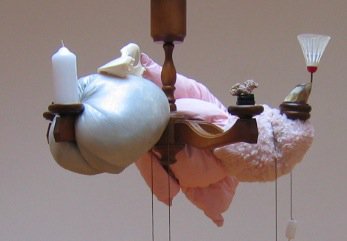Nika Kupyrova (born 1985) works in the field of installation and photography exploring the boundaries between the public and private space. The artist works with found materials to investigate the narrative potential of the ready-made and use it to create new fictional stories.
Her installations are a kind of synthesis of human habitats, as she reconstructs the movements and lifestyles to trace the imprint left by the former inhabitants on their immediate surrounding.
Nika Kupyrova found herself attracted to the light distribution and its architectural qualities in the space of Communication Space Školská 28. She uses windows and skylights as communication portals, spaces to enter and to the escape from.
"Our concept of a living space is based on windows. The room without windows is a nightmare, while large windows are a sign of social status and luxury. Windows are present even if we can‘t see through them: in the subway or in the elevators.
The window is a guarantee of escape - a sign of comfort. The window also marks the border between intimacy and isolation, which is evident in our culturally dependent everyday manipulations with the curtains. We want to look outside, but we don’t want to be seen. But most of all, we want to switch on the artificial light, so we can hide from the real darkness".
Nika Kupyrova, August 2010
Nika Kupyrova is visual artist, a graduate of the Edinburgh College of Art, currently working in Vienna and Prague. In her work she focuses mainly on mixed-media installation and photography that use re-assembled found materials to explore the qualities of the space as a habitat and as a concept of "home".
Essential to her concept of readymade is the ability of such objects to create an emotionally coloured space, which is then narrated by the artist through deliberate suggestions and visual clues. Her installations glamourise domesticalities, offering an insight into a fictional habitat; explore the routines; the eccentricities; and homemade erotica. The substance of those artificial living spaces is the inherent contradiction between their theatrical qualities and an abandoned habitat, deliberate exposure and trespass into the intimate landscape.
Her interest in habitats partly relates to the upbringing in the post-USSR nomadic lifestyle of her family. She is attracted to the adaptable qualities of the objects in living spaces and skills of temporary home-making. Overtime, the unfamiliar space becomes a personal comfort zone. Her work sythezises those living spaces, mapping the history of the individual through the traces left on their inanimate surroundings. The resulting multi-layered, tactile pieces use the past functions and sentiments of the original materials to invite the viewers to become poetic Frankensteins of the fictional past.




